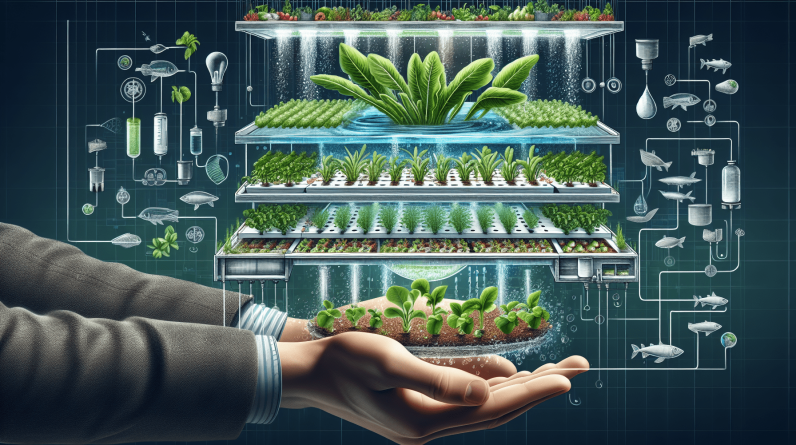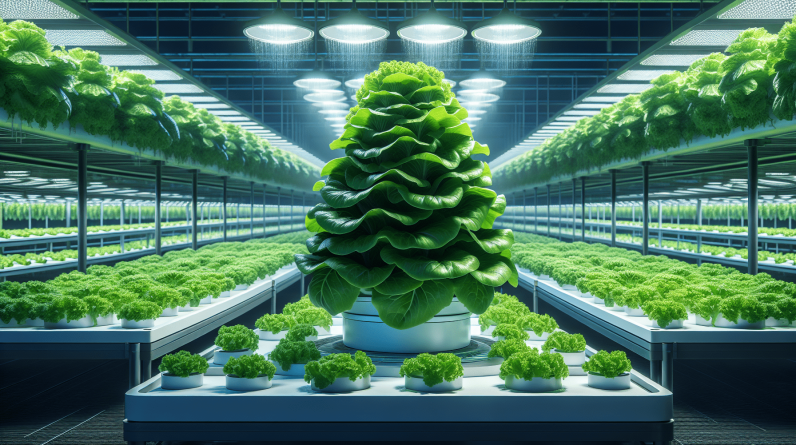
Have you ever considered starting your own hydroponic garden, but weren’t sure where to begin? In this article, we’ll guide you through the basics of hydroponic gardening for beginners, providing you with the knowledge and tools you need to get started successfully. Whether you have limited space, want to grow produce year-round, or are simply looking for a new gardening challenge, hydroponics can be a rewarding and efficient way to cultivate fresh, healthy crops right at home. Let’s delve into the world of hydroponic gardening and learn how you can set up your very own system.
What is Hydroponic Gardening?
Hydroponic gardening is a method of growing plants without using soil. Instead, plants are grown in a nutrient-rich water solution that delivers all the essential minerals they need to thrive. This controlled environment allows for faster growth and higher yields compared to traditional soil gardening. By bypassing the need for soil, hydroponic systems can conserve water, reduce the risk of soil-borne diseases, and provide an optimal growing environment for plants.
Why Choose Hydroponic Gardening?
Hydroponic gardening offers several advantages over traditional soil gardening. For one, it uses up to 90% less water, making it a more sustainable option, especially in areas prone to drought. The controlled environment of hydroponic systems allows you to grow plants year-round, regardless of external weather conditions, providing a consistent harvest. Additionally, hydroponic gardening eliminates the need for weeding or tilling soil, reducing physical labor and creating a cleaner, more efficient growing space.
Types of Hydroponic Systems
There are several different types of hydroponic systems to choose from, each with its own unique advantages and challenges. Depending on your space, budget, and level of experience, you can select the system that best suits your needs.
Wick System
The wick system is one of the simplest and most beginner-friendly hydroponic setups. It consists of a reservoir of nutrient solution, with a wick (usually made of cotton or felt) that draws the solution up to the plant’s roots. This passive system is easy to set up and maintain, making it a popular choice for first-time hydroponic gardeners.
Deep Water Culture (DWC)
In a Deep Water Culture system, plant roots are submerged in a nutrient solution, which is oxygenated through the use of an air pump and airstone. This constant supply of oxygen helps prevent root rot and promotes healthy growth. DWC systems are relatively simple to assemble and are suitable for growing a wide variety of plants, from leafy greens to herbs.
Nutrient Film Technique (NFT)
The Nutrient Film Technique involves a continuous flow of nutrient solution trickling down a channel, with plant roots exposed to the flowing film. This system requires precise control over the flow rate to ensure that roots receive enough nutrients and oxygen. While NFT systems can be more complex to set up, they are ideal for growing plants like lettuce and strawberries that thrive in a low-medium nutrient environment.
Ebb and Flow (Flood and Drain)
Ebb and Flow systems operate by flooding the growing tray with nutrient solution at regular intervals, then draining it back into the reservoir. This cyclical flooding and draining provide oxygen to the roots while delivering nutrients, creating a balanced growing environment. Ebb and Flow systems are versatile and are suitable for a wide range of plants, making them a popular choice for beginners and experienced gardeners alike.
Aeroponics
In an aeroponic system, plant roots are suspended in the air and misted with a nutrient solution at regular intervals. This method maximizes oxygen exposure to the roots, promoting fast growth and increased nutrient absorption. While aeroponics requires more precise monitoring and maintenance, it offers a highly efficient and productive way to grow plants, especially those with delicate roots like herbs and lettuce.

This image is property of images.unsplash.com.
Setting Up Your Hydroponic Garden
Now that you have an understanding of the different types of hydroponic systems available, it’s time to set up your own garden. Follow these steps to create a successful hydroponic setup that will yield fresh, healthy produce in no time.
Step 1: Choose a Suitable Location
Select a location for your hydroponic garden that receives an ample amount of natural light, whether it’s a sunny window sill, balcony, or dedicated grow room. Consider factors like temperature, humidity, and ventilation to create an optimal growing environment for your plants.
Step 2: Select a Hydroponic System
Based on your space, budget, and the types of plants you want to grow, choose a hydroponic system that aligns with your needs. Consider the level of maintenance required, the types of plants suited to each system, and your experience level in hydroponic gardening.
Step 3: Gather Necessary Supplies
Depending on the type of hydroponic system you choose, gather the necessary supplies such as reservoirs, growing containers, nutrient solutions, pH testing kits, growing medium, and lighting. Make sure to read the instructions carefully and follow the manufacturer’s recommendations for each component.
Step 4: Assemble Your System
Follow the instructions provided with your hydroponic system to assemble the components correctly. Pay close attention to details like water levels, nutrient concentrations, and pH levels to ensure that your system is set up for success. Test the system thoroughly before adding plants to ensure everything is functioning properly.
Step 5: Start Growing Plants
Once your hydroponic system is set up and running smoothly, it’s time to start growing plants. Choose seeds or starter plants that are suited to hydroponic gardening, such as leafy greens, herbs, tomatoes, or strawberries. Monitor the growth of your plants closely, adjusting nutrient levels and environmental conditions as needed to promote healthy growth.
Maintenance and Care Tips
To ensure the success of your hydroponic garden, it’s important to maintain and care for your system regularly. Follow these tips to keep your plants thriving and your system running smoothly.
Monitor Nutrient Levels
Regularly check the nutrient levels in your hydroponic system to ensure that plants are receiving the necessary minerals for growth. Adjust the nutrient solution as needed to maintain optimal levels for healthy plants.
Maintain pH Levels
Monitor the pH levels of your nutrient solution regularly using a pH testing kit. Most plants prefer a slightly acidic pH range of 5.5 to 6.5 for optimal nutrient uptake. Adjust the pH as needed using pH up or down solutions to keep your plants healthy.
Inspect Plant Health
Check your plants regularly for signs of nutrient deficiencies, pests, or diseases. Look for yellowing leaves, stunted growth, or unusual spots on plant foliage. Address any issues promptly to prevent them from spreading and impacting the overall health of your garden.
Clean and Sanitize Your System
Periodically clean and sanitize your hydroponic system to prevent algae growth, mineral buildup, and other contaminants. Disassemble and clean the components, such as reservoirs, tubes, and pumps, using a mild detergent or hydrogen peroxide solution. Rinse thoroughly before reassembling the system.
Optimize Lighting and Temperature
Ensure that your plants are receiving adequate light and optimal temperature conditions for healthy growth. Position grow lights at the correct distance from plants to prevent burning or stretching, and maintain a consistent temperature range suitable for the plants you are growing.

This image is property of images.unsplash.com.
Troubleshooting Common Issues
Even with proper maintenance, you may encounter some common issues in your hydroponic garden. By identifying and addressing these problems promptly, you can prevent them from affecting your plants’ health and productivity.
Root Rot
Root rot is a common issue in hydroponic systems caused by overwatering, poor oxygenation, or nutrient imbalances. To prevent root rot, ensure that your plants have access to sufficient oxygen, maintain proper water levels in the reservoir, and monitor nutrient concentrations regularly.
Nutrient Deficiencies
Plants in hydroponic systems may experience nutrient deficiencies due to imbalances in the nutrient solution. Monitor plant health for signs of yellowing leaves, stunted growth, or poor fruit development, which may indicate a lack of essential minerals. Adjust the nutrient solution accordingly to restore balance and promote healthy growth.
Algae Growth
Algae growth in hydroponic systems is a common issue caused by exposure to light, warm temperatures, and excess nutrients. To prevent algae buildup, cover light-exposed components with opaque materials, maintain proper temperature levels, and avoid overfeeding plants with nutrient solution.
Pests and Diseases
While hydroponic gardening reduces the risk of soil-borne pests and diseases, plants may still be susceptible to common pests like aphids, spider mites, or whiteflies. Inspect your plants regularly for signs of infestation, such as webbing, tiny insects, or yellowing leaves. Treat affected plants with organic pesticides or insecticidal soaps to control pests and prevent further damage.
Harvesting and Enjoying Your Produce
After weeks of nurturing your plants and maintaining your hydroponic system, it’s time to reap the rewards of your hard work. Harvest your produce when it reaches maturity, following specific guidelines for each type of plant you are growing. Whether you’re picking fresh herbs for cooking, harvesting ripe tomatoes for salads, or enjoying crisp lettuce in a salad, savor the fruits of your labor and enjoy the satisfaction of growing your own food.
Now that you have a comprehensive understanding of hydroponic gardening for beginners, you’re ready to start your own hydroponic garden and embark on a rewarding growing journey. By following the steps outlined in this article and applying the tips and techniques provided, you can create a thriving and productive hydroponic system that yields fresh, nutritious crops all year round. Happy gardening!










